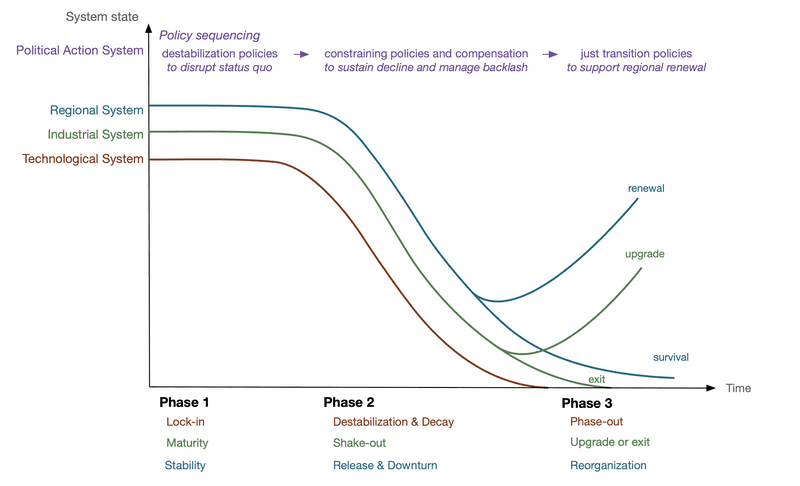12. April 2022Lessons for phasing out coal
To mitigate climate change, rapid and massive phase-out of coal-based power generation is required globally. At COP26, 46 countries signed the ‘Global Coal to Clean Power Transition Statement’, ‘consigning coal to history’, including significant coal consumers such as Indonesia and Vietnam. Translating the experience of just transition policies from developed countries to emerging and developing economies is a crucial policy challenge for the coming years. We developed a diagnostic tool to help researchers and policy makers most effectively translate these lessons.
Our starting point is that coal phase-out gives rise to three interconnected policy problems: first, the phase-out of coal technology in energy generation, second, the transformation of companies in the industry that use these technologies, and third the recovery of regions that depend on coal resources and assets. What can be learned from countries that are further along in the process of phasing out coal power generation to support emerging coal phase-outs through public policy?
To derive and transfer lessons of coal phase-out across cases, it is not only important to consider the economic and political setting of the country (for example, wether energy demand rises or whether governance is democratic and transparent), but also to be sensitive to the phase of decline the technology, industry and regions are in – this can inform effective and feasible policy sequencing throughout the different phases of decline.

We argue that technologies, industries and regions undergo three phases of decline: in Phase 1, the technology is locked in, the industry is mature and the region is stable. All three systems are tightly connected. The biggest risk is continuation of the status quo and a lack of technological decline – this is why destabilization policies may be needed to disrupt the status quo. In South Africa, for example, the coal power generation seems firmly locked in and the industry is mature and dominated by Eskom – but there are plans to break up Eskom’s monopoly over power generation and distribution.
If implemented, this policy may contribute to disrupt the status quo and push the technology in Phase 2 – destabilization and decay. In this phase, it is likely to see a shake-out as revenues within the industry decline and firms may go bankrupt. The regions need to release firms and technology, and are likely to enter a downturn as tax revenues and available jobs decline. In the US, for example, the number of mining companies has declined since 2013, and consequently the tax revenue in mining regions such as Appalachia and the Powder River Basin is decreasing. This may lead to backlash against the decline, requiring policies to compensate actors and at the same time sustain decline.
In Phase 3, the technology is phased out, and there are two possible pathways for related industry and regions. Firms in the industry either exit by moving abroad or going bankrupt, or they upgrade by investing in another technology. Regions enter either a survival mode if regional companies exit and are not replaced by new companies, or they enter regional renewal with new companies, rising tax revenue and more available jobs. In the case of coal mining phase-out in the Netherlands, the main coal company Dutch State Mines (DSM) upgraded and first substituted coal for gas, and later switched to the chemicals sector. If companies exit in Phase 3, it may be especially important to support regional development and renewal through just transition policies.
This framework is useful for both policymakers and researchers, especially as countries look to each other for lessons from coal phase-out strategies. We believe that to formulate sound policy advice, it is crucial not only to understand the geographical and political setting but also the phase of decline in which a policy was implemented, to understand whether a similar policy may be feasible and effective in another case. The framework may also be useful to advance other research agendas, such as mapping justice implications, actor perceptions and strategies related to phase-out. An additional further research agenda analyzes which technologies substitute the declining carbon-intensive technologies – breaking lock-in is one policy challenge but it is not always low-carbon alternatives that rush-in to take their place, as the example of the Netherlands and even Germany shows.
Further reading:
Nacke, L., Cherp, A., Jewell, J. (2022). Phases of fossil fuel decline: Diagnostic framework for policy sequencing and feasible transition pathways in resource dependent regions. Oxford Open Energy, 1, oiac002. https://doi.org/10.1093/ooenergy/oiac002.
Nacke, L. (2022). Lessons for phasing out coal. Political economy of Energy Transitions. https://www.polet.network/blog/lessons-for-phasing-out-coal.
Authors
Lola Nacke
PhD Student | Chalmers University of Technology
Department of Space, Earth and Environment, Division of Physical Resource Theory
Editor
Senior Researcher | Wuppertal Institute for Climate, Environment and Energy
Energy, Transport, and Climate Policy Division